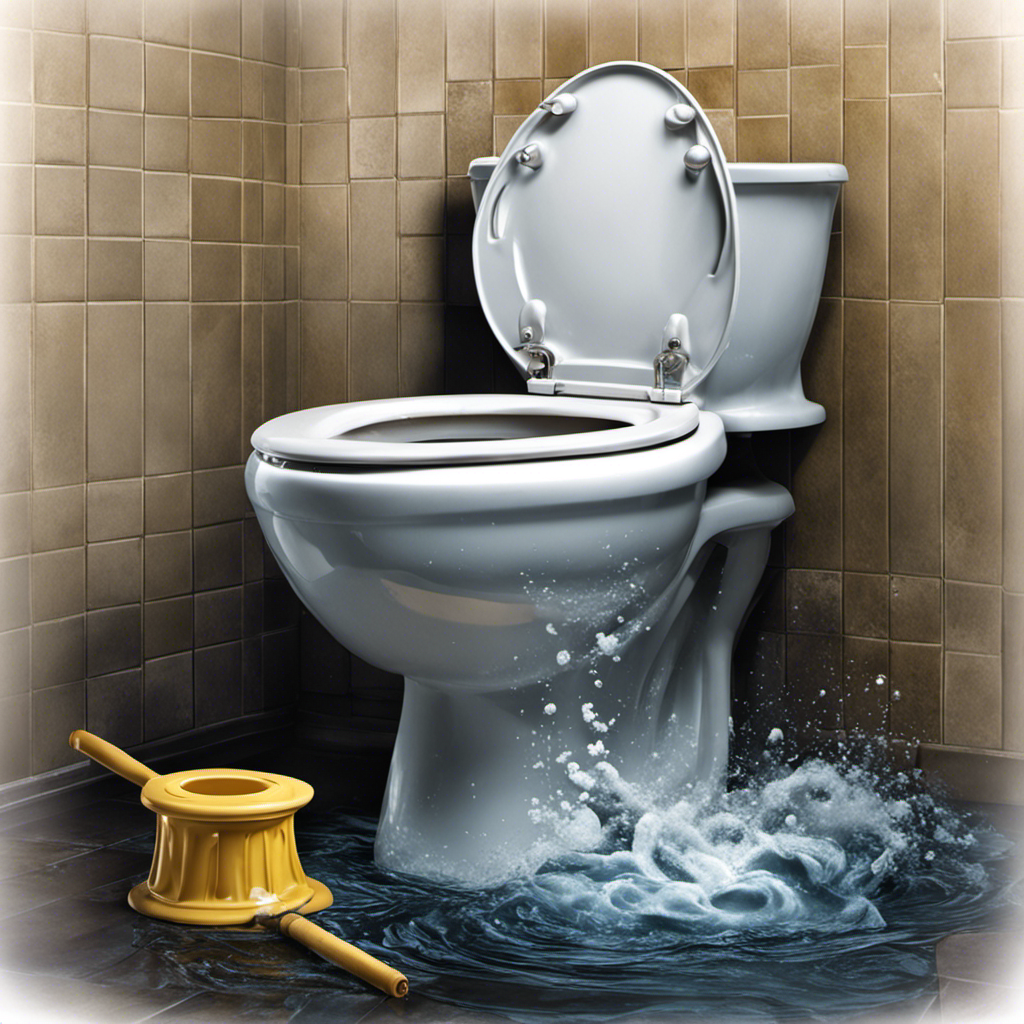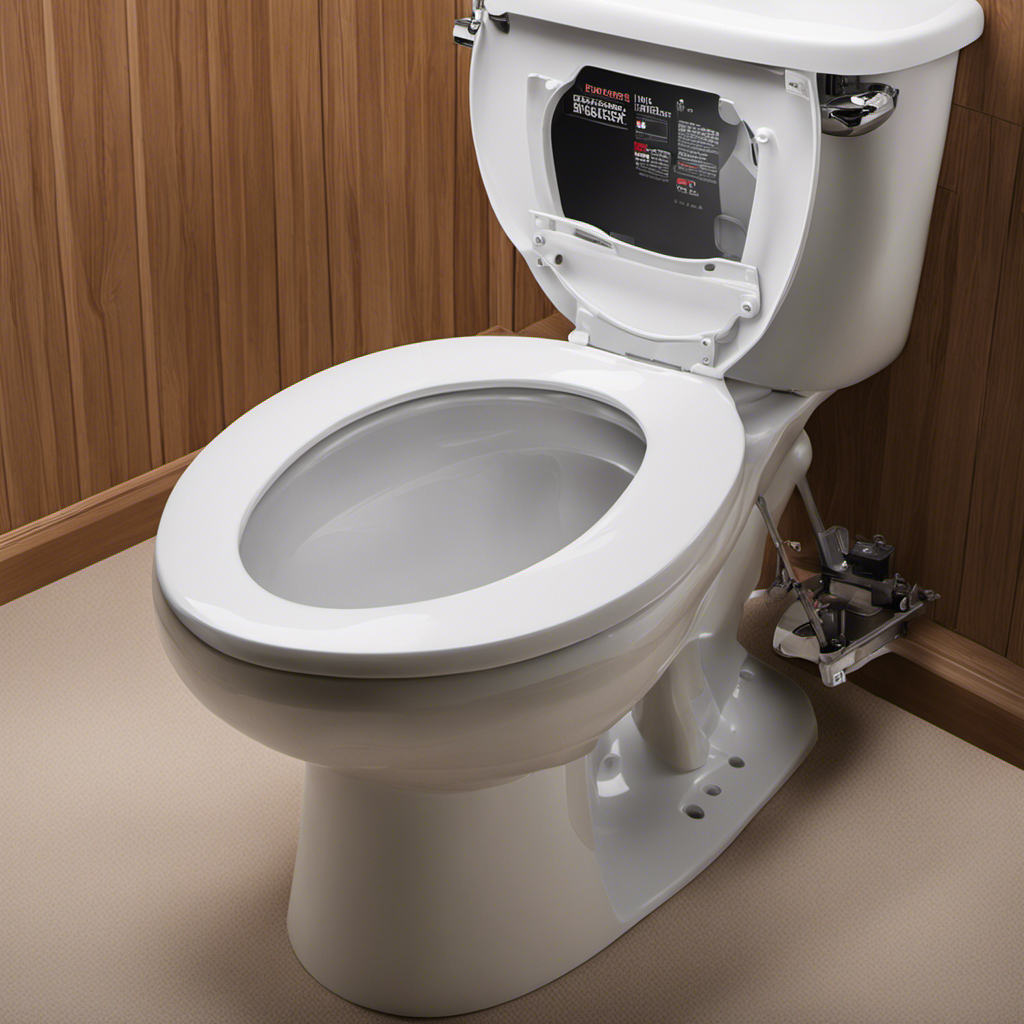I’ve been there before – standing in front of a clogged toilet, feeling frustrated and unsure of what to do next. But fear not! In this article, I’ll share with you my tried and true method for clearing a toilet clog.
Armed with the right tools and a step-by-step guide, you’ll be able to tackle even the most stubborn clogs with ease. So grab your plunger and let’s dive into the world of toilet unclogging!
Key Takeaways
- Clogged drains can be caused by materials like toilet paper, sanitary products, or excessive waste build-up.
- Water rising instead of draining properly may indicate a blockage in the trapway or main sewer line.
- Flushing foreign objects such as toys, wipes, or excessive toilet paper can lead to clogs.
- Using a plunger, bucket, and rubber gloves are essential tools for clearing a toilet clog.
Understanding the Causes of Toilet Clogs
To understand why your toilet keeps getting clogged, you should know the common causes of toilet clogs.
One of the most common toilet problems is a clogged drain. This occurs when materials like toilet paper, sanitary products, or excessive amounts of waste build up and obstruct the flow of water through the pipes.
Another sign of a clogged toilet is when water starts to rise instead of draining properly. This can be caused by a blockage in the trapway or the main sewer line.
Additionally, flushing foreign objects such as toys, wipes, or excessive amounts of toilet paper can also lead to toilet clogs.
Understanding these common causes will help you identify and prevent future clogs, ensuring your toilet functions properly.
Essential Tools for Clearing a Toilet Clog
You’ll need a plunger, a bucket, and a pair of rubber gloves for this task. When it comes to clearing a toilet clog, having the right tools is essential.
Prevention is always the best approach, so remember to avoid flushing items that can easily cause blockages, such as excessive toilet paper, sanitary products, or foreign objects. However, accidents happen, and when they do, you’ll need to be prepared.
Start by donning your rubber gloves to protect yourself from any potential mess. Then, grab your trusty plunger and position it over the toilet drain. Apply downward pressure and vigorously push and pull to create suction and dislodge the clog.
If the plunger doesn’t work, you may need to try more advanced techniques such as using a plumbing snake or even dismantling the toilet. Remember, always exercise caution and consult a professional if you’re unsure.
Step-by-Step Guide to Plunging a Toilet
Having the right tools is essential when it comes to unclogging a toilet, so start by donning your rubber gloves.
Here’s a step-by-step guide to plunging a toilet:
- Position the plunger over the drain hole, ensuring a tight seal.
- Use a firm, downward motion to push the plunger down, then pull up quickly. Repeat this motion several times.
- If the clog doesn’t clear after a few attempts, try using a toilet snake or auger.
Toilet clog prevention is key to avoiding this messy situation in the first place. Consider these alternative methods for unclogging toilets:
- Hot water and dish soap: Pour a pot of hot water mixed with a few tablespoons of dish soap into the toilet bowl. Let it sit for a few minutes, then plunge.
- Baking soda and vinegar: Pour half a cup of baking soda, followed by a cup of vinegar, into the toilet bowl. Let it fizz for a few minutes, then plunge.
- Enzyme-based cleaners: These cleaners help break down organic matter and can be effective for preventing clogs.
Now, let’s move on to using a toilet auger to remove stubborn clogs.
Using a Toilet Auger to Remove Stubborn Clogs
First, make sure the toilet auger is fully extended before inserting it into the drain hole. Proper maintenance of your toilet auger is essential for its effective use and longevity. Regularly clean the auger after each use to remove any debris or residue that may have accumulated. Inspect the auger for any signs of wear or damage, such as bent or broken parts, and replace them if necessary. It is also important to be aware of the common signs of a toilet clog, such as slow drainage, gurgling sounds, or a foul odor coming from the toilet. By being proactive in your toilet auger maintenance and recognizing the signs of a clog, you can effectively clear stubborn clogs and maintain the functionality of your toilet.
| Toilet Auger Maintenance | Common Signs of a Toilet Clog |
|---|---|
| Clean after each use | Slow drainage |
| Inspect for wear or damage | Gurgling sounds |
| Replace damaged parts | Foul odor |
Prevention Tips to Avoid Future Toilet Clogs
To avoid future clogs, it’s important to be mindful of what you flush down the toilet. Here are some toilet clog prevention strategies:
-
Only flush toilet paper: Flushing items like wet wipes, feminine hygiene products, or paper towels can easily lead to clogs. Stick to flushing only toilet paper, as it is designed to break down easily in water.
-
Regular maintenance: Perform routine maintenance on your toilet to keep it functioning properly. This includes checking the water level, inspecting the fill valve and flapper, and ensuring there are no leaks or cracks.
-
Educate household members: Teach everyone in your household about proper toilet usage. Make sure they understand the importance of not flushing anything other than toilet paper down the toilet. This will help prevent accidental clogs and keep your plumbing system running smoothly.
Frequently Asked Questions
Can I Use Chemical Cleaners to Clear a Toilet Clog?
Yes, you can use chemical cleaners to clear a toilet clog. However, it’s important to note that their effectiveness may vary. There are also alternative methods available to clear toilet clogs if you prefer.
How Do I Know if the Clog Is in the Toilet Bowl or in the Drain Pipe?
To determine if the clog is in the toilet bowl or drain pipe, I would first try using a plunger. If that doesn’t work, I might need to use a snake or consider calling for professional help.
Can I Use a Plunger on a Clogged Toilet With a Septic System?
I wouldn’t recommend using a plunger on a clogged toilet with a septic system. Instead, try using a toilet snake. It’s a more efficient and septic-friendly option to clear the clog.
What Should I Do if the Clog Is Too Stubborn to Be Cleared With a Plunger or Auger?
If the clog is too stubborn for a plunger or auger, there are alternative methods to try. However, if those fail, it may be time to call in professional help to clear the toilet clog.
Is It Possible to Prevent Toilet Clogs by Changing My Flushing Habits?
Toilet clog prevention and flushing techniques can indeed prevent stubborn clogs. By adjusting my flushing habits, I can avoid future plumbing disasters and keep my toilet running smoothly.
Conclusion
In conclusion, clearing a toilet clog may seem daunting, but it can be easily accomplished with the right tools and techniques.
By understanding the causes of toilet clogs and using essential tools such as a plunger or a toilet auger, you can effectively remove even the most stubborn clogs.
Remember to take preventative measures to avoid future clogs, such as using less toilet paper or avoiding flushing non-flushable items.
With a little knowledge and practice, you’ll become a pro at unclogging toilets in no time!










